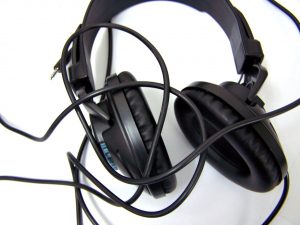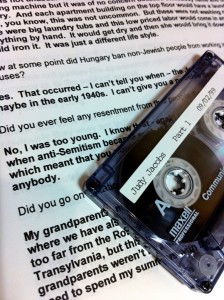Coming back to work on transcriptions for LaBudde after having worked on transcriptions from interviews I had conducted for the LatinxKC project has been a little bit of an adjustment. It is interesting looking at the interviews now from the perspective of having finished the oral history class as opposed to my thoughts while I was taking the class. I remember the frustration of trying to hear and sort out many voices as opposed to just one voice, but I have now come to see the place for different approaches. Having read about the therapeutic benefits of a group interview, I can see why someone might choose the more informal round table method as a way to preserve history. I can also see the benefits of a monologue and removing some of the external sources of intimidation which might threaten to question a person’s memory. One of the primary take aways I had from the oral history course was the importance of memory and finding how events felt and were remember for individuals and communities. I have noticed that one benefit of a relaxed group is that the group self corrects some of the flows in memory in such a way that it allows for the speaker to preserve their memory of the event in a less threatened way. Although the little group may correct each other on the dates, the shared community of the group, particularly in the lesbian round table interview I’m working with, seems to be very conscious and sensitive towards the feelings and memories of the other group members. Yet, I have also found that self correction occures for individuals without the group, such as in the monologue I have transcribed. The difference is that a group self correcting often becomes chaotic and the very corrections the group wishes to impose can be lost within the jumble of words, laughter, and jesting which are usual benefits of such groups. The individual on the other hand, when self correcting, is limited to their own conflicting recollection, and although more understandable, the corrections can still result in relatively jumbled and uncertain conclusions. What the monologue style confession does give is a free flow of what the narrator finds important. I say confession, because with the existence of the microphone, the narrator is still very aware that they are speaking to other people and wants to please those listeners. They must do so, however, without those listeners being there to give supportive listening cues or to directly participate in the guiding of the conversation. So, in some ways, the monologue is the most authentic confession of the person’s memories and values of what was important. But in other ways, the lack of a living person and the smile or nod of their head, can leave narrators monologueing to expectations which are not even there.
The group interview, in contrast, would appear to have the greatest level of interruptions, tangents, and outright questioning of the narrator’s memory. Yet, the comfort of having friends and a shared sense of support and community in the group interview of the lesbian round table allowed the speakers to question each other without fear. Thus, despite the frequent outbursts of laughter and side comments, the group is comfortable and most members are able to reflect on the events and what it felt like to them.
On a more critical note, I do not believe I would prefer to conduct either of the interview forms I’ve been transcribing. The monologue, while therapeutic and potentially more comfortable for the speaker, holds potential pitfalls in the assumption that the narrator will no longer be nervous with the living person being removed and the cold inanimate judgment of the tape recorder remaining. Yet, if I had gotten an interview with the narrator (which was the case of the monologue) then a monologue might allow the narrator to speak and contradict me in a safer nonconfrontational format. This is a worthy benefit, especially if there were conflicting memories and perspectives of events and places between the interview and the monologue’s account.
I also do no believe I’d want to do the group interview either, but for different reasons. Although the group interview could be more comfortable and allow for womens voices to be presented in a more natural and freeing way, the difficulty of hearing such voices can be a problem. Although the group interview provides a great sense of the group’s relationships and community, as well as still effectively conveying key points if the narrators’ views, it can also lose the particular views and memories of some of the individual members. The group reflection allows for sparked memories to be added to the narrative and a weaving of stories and fragments into a group sense of shared experience. The individual strands and story treads which contribute to the overall weave are visible, but can be lost in the blending of so many stories and threads. I have noticed that some of the quieter narrators in the group interview tend to be overtalked and some individuals with differing perspectives can be ganged up on by more vocal or forceful speakers. Some of the softer spoken narrators can be lost in the midst of background jesting or bombastic laughter. While creating a great sense of the group and allowing a format which sparks recollections, reflections, and additional details to stories, the different individual perspectives and memory of events can be lost in a group interview. Most of this is because the additional details and freedom to jump in create overtalking. More importantly, the round table group interview was so comfortable that it allowed some narrators to jump in late in the recording, or suddenly appear on record when they had silently been participating the whole time. The increase of influencing factors and visual cues present in the round table makes an audio recording confusing to listen to. Without a visual recording included with the audio it is, at times, nearly impossible to know who and what is being talked to or about. Individual interviews with each person would have allowed for much deeper and complete interviews in many ways, esoecially for the more timid speakers. Again, the group interview does provides a sense of the groups memory and also allows for contributions to each other stories by the narrators in ways which cannot be discounted. Yet, without individual interviews, I can’t help but wonder if the stories told by the group are those the quieter members would have told on their own, or if the stronger members of the group, with the best of intentions or without even knowing it, guided the group into a memory distinctly imprinted with their leadership.


